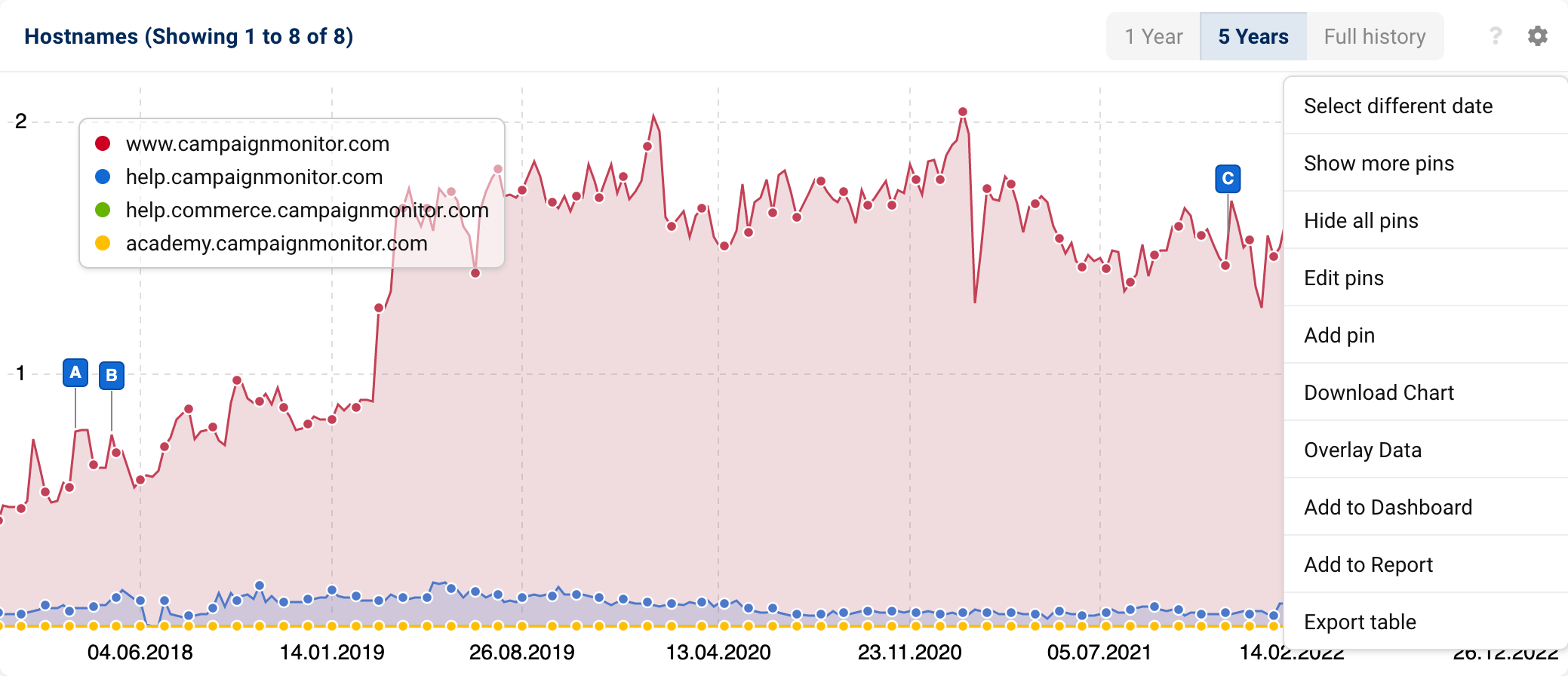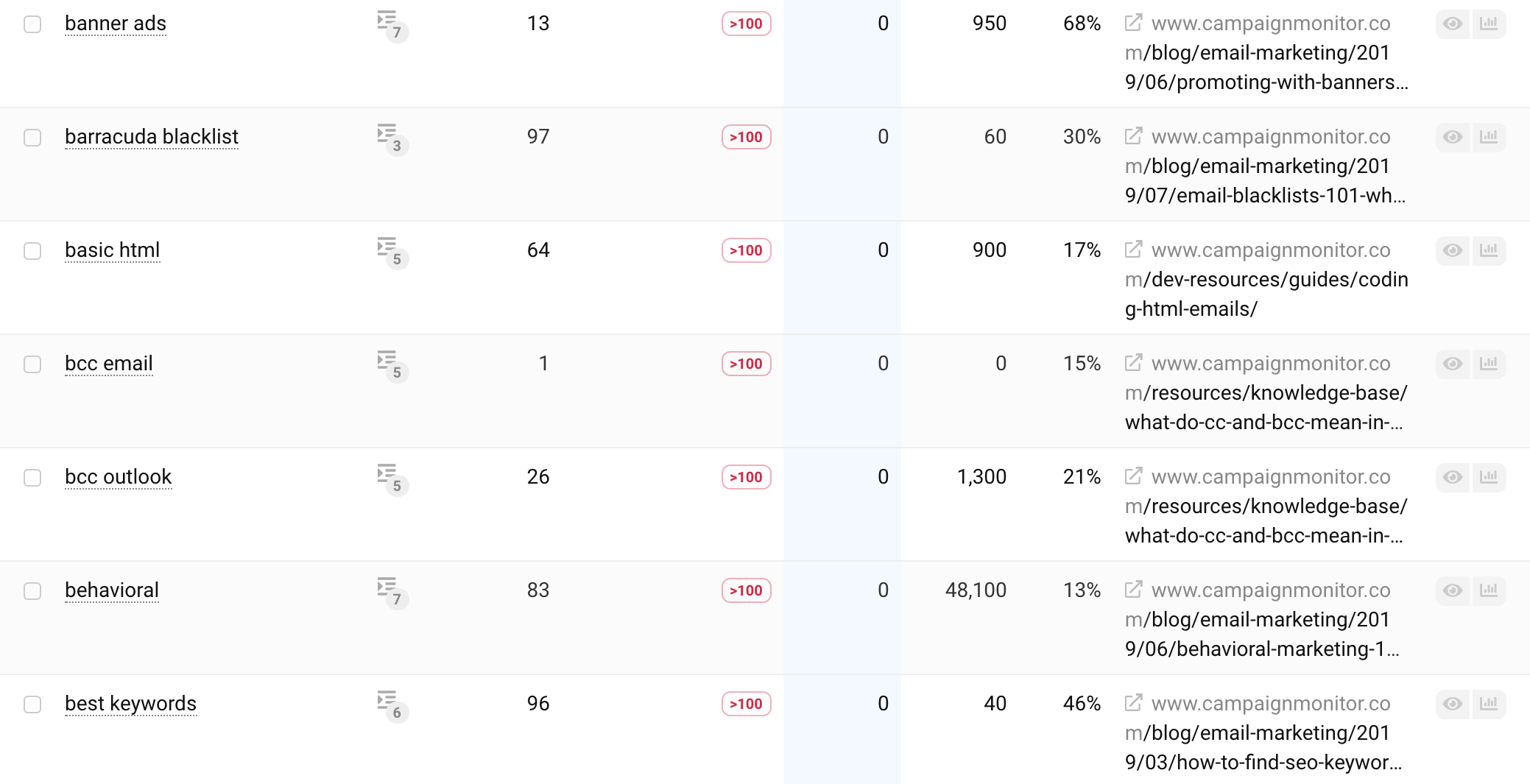It is not an uncommon occurrence that a domain’s visibility suddenly drops drastically from one week to the next. It is important to identify the cause(s) and to take the necessary steps to remedy this. In this tutorial, we will show you an example of an affected domain and an analysis of what you can do.
- Recognising a Domain Crash in the SISTRIX Visibility Index
- Checking Hostnames for Loss of Visibility
- Checking Directories for Loss of Visibility
- Checking Ranking Changes for Lost Keywords
- Checking the Ranked Contents for Availability
- Checking the Previously Ranked URL of a Keyword in the SERP Archive
- Conclusion
- Recommended Solution
- Tip: Documenting your findings with an event pin
The three most common causes that can lead to massive fluctuations in the Visibility Index of a domain are algorithmic or manual Google Penalties, a relaunch of the website and a competitor gaining visibility.
Recognising a Domain Crash in the SISTRIX Visibility Index
Now let’s take a look at a domain that suddenly lost a massive amount of visibility. The interesting part: with SISTRIX you can not only analyse the current ranking loss of a domain, but also changes in the past. Our example is from 2021.

The visibility of the domain campaignmonitor.com dropped drastically from January 25th to February 8th, 2021.
Of course, there is no “one” way to find out why the visibility dropped so massively. However, in the following, we will show you one possible way to analyse the results in SISTRIX.
Checking Hostnames for Loss of Visibility
If you notice a significant change in the visibility history of a domain, select the menu item Hostnames in the navigation on the left side in SISTRIX, in the picture below at 1.
Through this analysis, we want to find out whether the loss of visibility of the domain can be traced back to one specific hostname or multiple hostnames.
This chart always shows the top four hostnames which contribute the most to the visibility of the domain. By clicking on the colour-coded tick icon in the table below that 2, the visibility graphs of the various hostnames can be shown and hidden and other hosts that do not belong to the top hostnames can also be examined.
It is clear that the loss in the domain’s visibility is due to the hostname www.campaignmonitor.com 3. With around two visibility points, it is the hostname with the greatest visibility.
You can adjust the date of the table by clicking on the cogwheel icon in the top right corner of the graph (it appears when you move the mouse in the graph) and choosing “Select different date“.
Thus, we continue to look for the cause of the loss of visibility. In the next step of our analysis, we go a bit deeper and look at the directories of the domain.
Checking Directories for Loss of Visibility
On the left-hand navigation, select the menu item Directories. By default, the visibility history of the last five years is displayed here based on mobile data.
Using the “Options” field above the chart, we switch the data source to desktop data 1 and, just as described above, we select a date before the loss using the cogwheel icon in the chart and “Select different date” 2, in our case January 25th, 2021. Finally, if the date analysed lies further back in time, you can also use the button “Full history” 3 to view the data up to that point in the chart.
Using this analysis, you can see whether the visibility loss of the domain can be traced back to one specific directory or multiple directories. Often, one of the top 3 directories that generate the majority of the domain’s visibility can be pinpointed as a potential cause for the visibility crash.
For our example, we find that all relevant directories of the domain campaignmonitor.com have lost visibility.
Checking Ranking Changes for Lost Keywords
A loss in the SISTRIX Visibility Index can always be traced back to a loss or a decrease of ranking positions for valuable keywords.
Since you were able to already exclude the possibility of a specific hostname or directory being responsible for the visibility loss for the domain, you now have to identify the keywords that have drastically lost ranking positions.
You can do this via the menu item Ranking Changes in the navigation on the left side.
Like before, select the desktop data as the data source in the “Options” menu first 1.
In the second step, define the date range that you want to compare 2. To identify the keywords responsible for the loss of visibility, choose the week before the crash as date #1 and the week when you noticed the change in the Visibility Index of the domain as date #2.
In this case, we will choose January 25th, 2021 and February 8th, 2021.
In the third and last step, you filter the data according to the ranking change you want to analyse at 3. Here, the lost keywords are relevant.
You will then get a list of keywords, including their absolute changes of position within the selected timespan.
The table shows the ranking positions of the keywords that had a top ranking at the time before the visibility crash and compares these with the ranking position at the time of the crash.
An additional look at the ranking changes of the type “Lost Top 10 Keywords”, marked in the image with , shows you all keywords that may still have a top 100 ranking but are no longer among the first ten Google results at the second point in time.
In the case of the domain campaignmonitor.com, you can see that many top ranking positions for valuable keywords have dropped drastically. In some cases, the ranking positions have fallen by over 90 places, i.e., from the first Google results page to the tenth. Other valuable keyword placements have completely dropped out of the top 100 search results.
Now we need to find out what caused these drastic ranking losses.
Checking the Ranked Contents for Availability
Why did these keywords drop so massively in their ranking position? Often the reason lies in the fact that the ranking URL cannot be retrieved and returns a 404 error code, for example, or was not redirected. For instance, if the URL structure was renamed, but no 301 redirect was used.
Therefore, you check whether the ranking content is accessible.
Checking the Previously Ranked URL of a Keyword in the SERP Archive
To check whether this also applies for the domain campaignmonitor.com, we analyse the lost keywords based on their ranking history. Here, we use the keyword “bcc email” as an example.
You can find the ranking history for the respective keyword for the examined domain in the last position of the table under the chart symbol, pictured above at 1.

In the Ranking History, you can then see the development of the domain’s rankings. By default, we show you the last 12 months in the history. If the point in time you want to analyse lies more than one year in the past, as in our example, please scroll down the page to the end of the table and click on “Show all rankings“. Now the complete history will be loaded.
Here, the change in position of the domain for the keyword in the corresponding week becomes clear once again. When the graph stops, it means that there were no rankings in the top 100 search results from that point on.
In the table below the history graph, you can see which URL ranked at which point in time. In our example, this was the URL https://www.campaignmonitor.com/resources/knowledge-base/what-is-the-code-that-makes-bcc-or-cc-operate-in-an-email/amp/ as of January 25th, 2021.
Now you need to check what occurs on the URL. To do this, simply open the URL from the Toolbox by clicking on the symbol with the arrow in the box in front of the URL.

After opening the URL, a 404 error page is displayed. The previously well-ranked URL for the keyword is not redirected to the new URL. This means that both the user and Google cannot find the content, and it can therefore no longer be taken into account by Google in the rankings.
Conclusion
The visibility loss of the domain is due to a new URL design that affects many valuable and well-ranking keywords. The non-existing 301 redirects from the old URL structure to the new one caused Google to sort out the content that can no longer be found from the search results pages.
In order to find all affected keywords that may not have been forwarded to a new URL structure, filter for lost and dropped keywords in the analysis step “Checking Ranking Changes for Lost Keywords“.
Recommended Solution
After making changes to the URL structure of a website or specific pieces of content, as well as after a site relaunch, the previous URL must always be redirected using an HTTP status code 301, with the new URL as a target.
Tip: Documenting your findings with an event pin
To always remember why the domain lost many points in the SISTRIX Visibility Index in the week of January 25, 2021, you should document your findings gained from the SEO analysis with an event pin.





